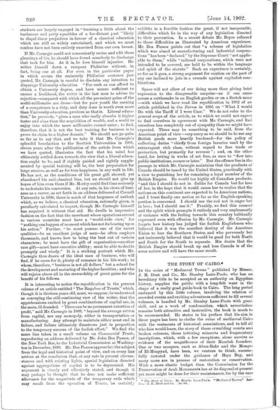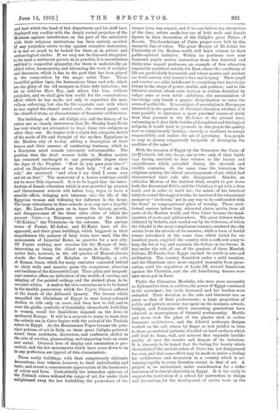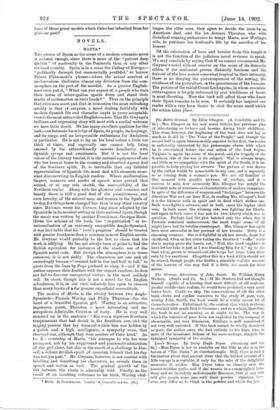THE STORY OF CAIRO.*
IN the series of "Mediaeval Towns" published by Messrs., J. M. Dent and Co., Mr. Stanley Lane-Poole, who has an hereditary title to be accepted as an authority on Egyptian_ history, supplies the public with a long-felt want in the shape of a really good guide-book to Cairo. The long period. embraced by this little volume, involving the relation of. crowded events and exciting adventures sufficient to fill several volumes, is handled by Mr. Stanley Lane-Poole with great skill, and as a work of condensation, which nevertheless remains both attractive and instructive, the book is much to be recommended. He states in his preface that his aim hi these pages has been to clothe the ruins of mediaeval Cairo- with the vestments of historical associations, and to tell all who fain would learn, the story of those crumbling courts and broken columns, those tottering minarets and fragmentary inscriptions, which, with a few exceptions, alone survive as evidence of the magnificence of their liamluk founders. One or two mosques, such as Abou-Bakr and the Mosque- of El-Muayyad, have been, we venture to think, success- fully restored under the guidance of Heyz Bey, and_ many more are in process of restoration or conservation. With a more elastic budget than the Commission for the Preservation of Arab Monuments has at its disposal at present yet more might be done for their maintenance, for by the care The Story of Cairo. By Stan'ey Lane-Poo'e. "Mei:coral Towns." Lon- J. M. Dent and Co. 4s. fid.
and tact which the head of this department and his staff have displayed any conflict with the deeply rooted prejudice of the Moslems against interference on the part of the unbeliever with their religions institutions has been entirely avoided. If any prejudice exists to-day against complete restoration, it is not so much to be looked for there as in artistic and archaeological circles. If we may not be disposed altogether to let such a sentiment govern us in practice, it is nevertheless entitled to respectful sympathy, for there is undoubtedly an added value, harmonising and enhancing the work of sculptor and decorator, which is due to the part that has been played in the composition by the magic artist Time. Those beautiful golden tints, the harmonious blues and reds, which are the glory of the old mosques in Cairo defy imitation ; but let us criticise Herz Bey, and others like him, without prejudice, and we shall give him credit for the conscientious effort which he has made, not only to reproduce the mar- vellous colouring, but also for the exquisite care with which he has copied the chased metal-work, the carved panel, and the chiselled stone, so characteristic of Saracenic architecture.
The buildings of the old Caliph city and the history of its rulers are so closely interwoven that Mr. Stanley Lane-Poole has very wisely not attempted to treat these two subjects as other than one. He begins with a slight but adequate sketch of the mode of life and thought of the modern Egyptians in the Moslem city of to-day, adding a description of their houses and their manner of conducting business, which to a European mind sounds extremely unbusinesslike. The position that the Arab woman holds in Moslem society has remained unchanged to any perceptible degree since the days of the Prophet. "How do you pass your time ? " asked an Englishwoman of an Arab lady. "I sit on this sofa," she answered, "and when I am tired I cross over and sit on that." The monotony of a harem existence could not be more fitly expressed. It is to be hoped that the intro- duction of female education which is now provided by mission and Government schools will before long begin to have a sensible effect, bringing new interests into the life of the Egyptian woman and widening her influence in the home. The large attendance in these schools is at any rate a hopeful sign. Mr. Lane-Poole goes on to trace the history, growth, and disappearance of the three older cities of which the present Cairo — a European corruption of the Arabic "El-Kahira," the Victorious—is the outcome. The ancient towns of Fustat, El-Askar, and El-Katai have all dis- appeared, and their great buildings, which beggared in their magnificence the palaces of fairy tales, were used, -like the monuments of Imperial Rome, as quarries for a new city. Of Fustat nothing now remains but the Mosque of Amr, interesting as being the oldest mosque in Cairo. Of still earlier date, however, in the old quarter of Masr-el-Ateeka stands the fortress of Babylon or Heliopolis, a relic of Roman times, which for many centuries concealed behind its thick walls and massive gates the sumptuous churches and basilicas of the distrustful Copt. Their plain and insignifi- cant exterior offers no indication of the wealth of carving and inlaying, of the painted ceilings and the stained glass, to be revealed within. A motive for this concealment is to be found in the terrible persecution which the Coptic Church suffered at the hands of the Abbassid dynasty. The decrees which compelled the Christians of Egypt to wear honey-coloured clothes, to ride only on asses, and then face to tail, and to wear the girdle, symbolic of femininity, thenceforth forbidden to women, recall the disabilities imposed on the Jews in mediaeval Europe. It will be a surprise to many to learn that the artistic era in Cairo begins with the arrival of the Turkish rulers in Egypt. As the Renaissance Popes became the prin- cipal patrons of art in Italy, so these great Caliphs gathered round them architects, decorators, and craftsmen skilled in the arts of carving, glassrnaking, and engraving both on stone and metal Oriental love of display and ostentation is pro- verbial, and the few monuments which have come down to us in any perfection are typical of this characteristic.
These costly buildings, with their sumptuously elaborate decorations, bear witness, however, to their individuality and taste, and reveal a consummate appreciation of the harmonies of colour and form. Undoubtedly the heterodox opinions of the. Fatimid rulers widened the range of art, for under their enlightened sway the law forbidding the portraiture of the
human form was relaxed, and if we can believe the chroniclers of the time, artists made free use of both male and female figures in their decoration of the Caliph's great Palace cf Kara& The foundations of Cairo proper were laid by this energetic line of rulers. The great Mosque of El-Azhar, the University of the Moslem world, still bears witness to their public-spirited initiative. Within its porticoes over nine- thousand pupils receive instruction from two hundred and thirty-nine unpaid professors, an example of free educatiom impossible anywhere outside the East, where the conditions of life are particularly favourable and where master and student are both content with hermit's fare and lodging. There pupil and teacher are alike indifferent to everything that knowledge brings in the shape of power, wealth, and position; and to the Oriental student, whose calm horizon is seldom disturbed by vulgar aims or even noble ambitious, the accumulation of knowledge only breeds a greater disinclination to enter the arena of public life. It is a subject of speculation to Europeans interested in the question of Oriental education whether, if it were possible to introduce a more practical course of study than that pursued in the El-Azhar at the present time, embracing as it does little besides philosophical and theological subjects, it would tend to promote in this people the quality now so conspicuously lacking,—namely, a readiness to accept responsibility, and realise the art of governing. Is a people so easy to govern congenitally incapable of developing the qualities of the ruler ?
With the invasion of Egypt by the Crusaders the Cairo of the:Fatimids fell into decay, one or two only of their build- ings having survived to bear witness to the luxury and magnificence which prevailed during the eleventh and twelfth centuries. At the same time the toleration for religious opinion, the liberal encouragement of art, which had characterised their rule also disappeared. Saladin, an orthodox Moslem of the strictest kind, sought to put down both the dissentient Schi'a and the Christian Copt with a firm hand, and in order to instil into the minds of his heretical subjects sound theological truths, he instituted the educational mosque or" medrassa," not in any way to be confounded with the Gana' or congregational place of worship. These intel- lectual centres before long attracted choice spirits from all parts of the Moslem world, and thus Cairo became the head- quarters of poets and philosophers. The great defence works initiated by Saladin, and carried out by his followers, of which the Citadel is the most conspicuous instance, rendered the city secure from the attacks of its enemies ; while a form of feudal tenure introduced at the same time, which lasted for six hundred years, supplied the country with a sufficient army kr keep the foe at bay and maintain the Sultan on his throne. It was under the rule of one of the greatest of these Mamluk Sultans, El-Nassir, that Egypt reached its zenith in arts and civilisation. The country flourished under a mild taxation, and the Christians once more enjoyed immunity from perse- cution, until the expedition of Louis IX. revived fanaticism against the Christian, and the old humiliating decrees were once more put in force.
Under the Circassian Mamluks, who were more successful as diplomatists than as soldiers, the power of Egypt continued in the ascendant ; her trade increased and her borders were extended. Their devotion to the arts and literature was as great as that of their predecessors ; a large proportion of public and private revenue was spent on the mosques, schools, bridges, and fountains which succeeding generations have admired as masterpieces of Oriental workmanship. Marble and stone took the place of the plaster used in earlier Saracenic architecture, and the foliated arabesque designs worked on the soft stucco by finger or tool yielded in turn to those geometrical patterns chiselled on hard surfaces which still lend to dome, wall, and minaret that exquisite lacelike quality at once the wonder and despair of its imitators. It is sincerely to be hoped that the feeling for beauty which characterised the ancient rulers of Cairo has not disappeared for ever, and that some effort may be made to revive a feeling- for architecture and decoration in a country which is ad- vancing rapidly in every direction except in that of art. A project is, we understand, under consideration for a wider extension of technical education in Egypt. Is it too early to suggest the institution of a school for instruction in design and decoration, for the development of native taste on the
lines of those great models which Cairo has inherited from her glorious past?












































 Previous page
Previous page